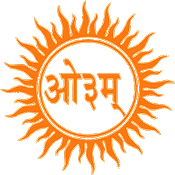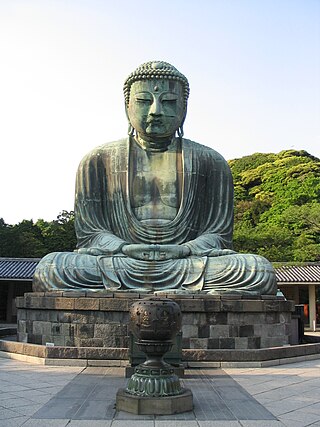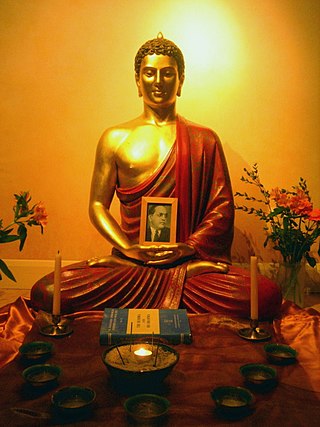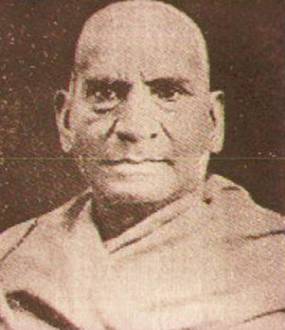Related Research Articles

Arya Samaj is a monotheistic Indian Hindu reform movement that promotes values and practices based on the belief in the infallible authority of the Vedas. The sannyasi (ascetic) Dayanand Saraswati founded the samaj in the 1870s.

Bhimrao Ramji Ambedkar was an Indian jurist, economist, social reformer and political leader who headed the committee drafting the Constitution of India from the Constituent Assembly debates, served as Law and Justice minister in the first cabinet of Jawaharlal Nehru, and inspired the Dalit Buddhist movement after renouncing Hinduism.

The Dalit Buddhist movement is a religious as well as a socio-political movement among Dalits in India which was started by B. R. Ambedkar. It re-interpreted Buddhism and created a new school of Buddhism called Navayana. The movement has sought to be a socially and politically engaged form of Buddhism.

Deekshabhoomi, also written as Deeksha Bhoomi, is a sacred monument of Navayana Buddhism located in Nagpur city in the state of Maharashtra in India; where B. R. Ambedkar with approximately 400,000 of his followers– mainly Dalits, several thousand of whom had been converted to Christianity– embraced Buddhism on Ashoka Vijaya Dashami on 14 October 1956. Ambedkar played a significant role in the revival of Buddhism in India, and inspired many such mass conversions to Buddhism.

Buddhism, also known as Buddha Dharma and Dharmavinaya, is an Indian religion and philosophical tradition based on teachings attributed to the Buddha, a wandering teacher who lived in the 6th or 5th century BCE. It is the world's fourth-largest religion, with over 520 million followers, known as Buddhists, who comprise seven percent of the global population. Buddhism originated in the eastern Gangetic plain as a śramaṇa–movement in the 5th century BCE, and gradually spread throughout much of Asia. It has subsequently played a major role in Asian culture and spirituality, eventually spreading to the West beginning in the 20th century.

Upāli was a monk, one of the ten chief disciples of the Buddha and, according to early Buddhist texts, the person in charge of the reciting and reviewing of monastic discipline on the First Buddhist Council. Upāli belongs to the barber community. He met the Buddha when still a child, and later, when the Sakya princes received ordination, he did so as well. He was ordained before the princes, putting humility before caste. Having been ordained, Upāli learnt both Buddhist doctrine and vinaya. His preceptor was Kappitaka. Upāli became known for his mastery and strictness of vinaya and was consulted often about vinaya matters. A notable case he decided was that of the monk Ajjuka, who was accused of partisanship in a conflict about real estate. During the First Council, Upāli received the important role of reciting the vinaya, for which he is mostly known.

Chamar is a Dalit community classified as a Scheduled Caste under modern India's system of affirmative action. They are found throughout the Indian subcontinent, mainly in the northern states of India and in Pakistan and Nepal.

Buddhism and Hinduism have common origins in the culture of Ancient India. Buddhism arose in the Gangetic plains of Eastern India in the 5th century BCE during the Second Urbanisation. Hinduism developed as a fusion or synthesis of practices and ideas from the ancient Vedic religion and elements and deities from other local Indian traditions.

Gurukula Kangri is a Government-funded Deemed to be University u/s 3 of the UGC Act 1956 located in Haridwar, Uttarakhand, India. It is fully funded by UGC/ Govt. of India. It is NAAC "A" grade accredited. Situated near the bank of the Ganges, Haridwar and about 200 km from New Delhi. Gurukula Kangri has 25 academic departments covering Engineering, Applied Sciences, Vedic Sciences, Humanities and Social Sciences and Management programs with a strong emphasis on Vedic and Modern Sciences and technological education and research. The university has signed about 34 memorandums of understanding with industries, universities, NGOs, and institutions.

Buddhism is an ancient Indian religion, which arose in and around the ancient Kingdom of Magadha, and is based on the teachings of Gautama Buddha who was deemed a "Buddha", although Buddhist doctrine holds that there were other Buddhas before him. Buddhism spread outside of Magadha starting in the Buddha's lifetime.

Navayāna, otherwise known as Navayāna Buddhism, refers to the modern re-interpretation of Buddhism founded and developed by the Indian jurist, social reformer, and scholar B. R. Ambedkar; it is otherwise called Neo-Buddhism and Ambedkarite Buddhism.

Swami Shraddhanand, also known as Mahatma Munshi Ram Vij, was an Arya Samaj sannyasi and an Indian Independence activist who propagated the teachings of Dayananda Saraswati. This included the establishment of educational institutions, like the Gurukul Kangri University, and played a key role on the Sangathan and the Shuddhi (purification), a Hindu reform movement in the 1920s.
Adi Dharm refers to the religion of Adi Brahmo Samaj the first development of Brahmoism and includes those Sadharan Brahmo Samajists who were reintegrated into Brahmoism after the second schism of 1878 at the instance of Devendranath Tagore. This was the first organised casteless movement in British India and reverberated from its heart of Bengal to Assam, Bombay State, Punjab and Madras, Hyderabad, and Bangalore.

The ten principal disciples were the main disciples of Gautama Buddha. Depending on the scripture, the disciples included in this group vary. In many Mahāyāna discourses, these ten disciples are mentioned, but in differing order. The ten disciples can be found as an iconographic group in notable places in the Mogao Caves. They are mentioned in Chinese texts from the fourth century BCE until the twelfth century CE, and are the most honored of the groups of disciples, especially so in China and Central Asia. The ten disciples are mentioned in the Mahāyāna text Vimalakīrti-nideśa, among others. In this text, they are called the "Ten Wise Ones", a term which is normally used for the disciples of Confucius.
Katti Padma Rao is a Dalit poet, scholar and activist from Andhra Pradesh, India. He is the founding general secretary of Dalit Mahasabha, a people's organisation that spearheaded the Dalit movement in Andhra Pradesh in the aftermath of the 1985 Karamchedu massacre in the coastal region of that state. A scholar in both Telugu and Sanskrit, he has published several volumes of poetry, and books on sociology, religion, philosophy, history, and women's studies. He is a regular columnist in major Telugu newspapers and magazines.
Arya is a term used in Buddhism that can be translated as "noble", "not ordinary", "valuable", "precious", "pure", "rich". Arya in the sense of "noble" or "exalted" is frequently used in Buddhist texts to designate a spiritual warrior or hero.

Marathi Buddhists are Buddhists of Marathi ethnic and linguistic identity. The religious community resides in the Indian state of Maharashtra. They speak Marathi as their mother-tongue. The Marathi Buddhist community is the largest Buddhist community in India. According to the 2011 Indian census, Marathi Buddhists constitute 5.81% of the population in Maharashtra, which is 77% of the total Buddhist population in India.
Swami Achhootanand was a 20th century Indian anti-caste intellectual, writer, and social reformer. A former Arya Samajist, he became disillusioned with the Arya Samaj and established the Adi Hindu movement. He was a poet, critic, dramatist, and historian.
Chandrika Prasad 'Jigyasu' (1880s/1890s—1974) was an Indian anti-caste intellectual, Hindi-language writer, and publisher of Dalit literature.
References
- ↑ Maren Bellwinkel-Schempp 2004, p. 222.
- 1 2 3 Maren Bellwinkel-Schempp 2011, p. 190.
- ↑ Maren Bellwinkel-Schempp 2004, pp. 222–223.
- 1 2 Maren Bellwinkel-Schempp 2004, p. 223.
- 1 2 3 4 5 Maren Bellwinkel-Schempp 2011, p. 206.
- 1 2 3 Maren Bellwinkel-Schempp 2004, p. 224.
- ↑ Maren Bellwinkel-Schempp 2004, p. 225.
- ↑ Maren Bellwinkel-Schempp 2004, pp. 225–226.
- 1 2 3 4 Maren Bellwinkel-Schempp 2004, p. 226.
- 1 2 Maren Bellwinkel-Schempp 2004, p. 227.
- 1 2 3 4 Maren Bellwinkel-Schempp 2011, p. 210.
- 1 2 3 Maren Bellwinkel-Schempp 2004, p. 233.
- 1 2 Maren Bellwinkel-Schempp 2011, p. 207.
- 1 2 3 Maren Bellwinkel-Schempp 2011, p. 211.
- 1 2 Maren Bellwinkel-Schempp 2011, p. 197.
- ↑ Maren Bellwinkel-Schempp 2011, pp. 212–213.
- ↑ Maren Bellwinkel-Schempp 2011, p. 123.
- ↑ Maren Bellwinkel-Schempp 2011, p. 209.
- ↑ Maren Bellwinkel-Schempp 2011, pp. 198, 210.
- ↑ Maren Bellwinkel-Schempp 2011, pp. 123, 211.
- 1 2 3 4 Maren Bellwinkel-Schempp 2011, p. 198.
- ↑ Maren Bellwinkel-Schempp 2011, pp. 198, 211.
Bibliography
- Maren Bellwinkel-Schempp (2011). Peter Schalf (ed.). Neuer Buddhismus als gesellschaftlicher Entwurf (PDF). Uppsala University. doi:10.1515/olzg-2015-0120. ISBN 978-91-554-8076-9.
- Maren Bellwinkel-Schempp (2004). "Roots of Ambedkar Buddhism in Kanpur". In Surendra Jondhale; Johannes Beltz (eds.). Reconstructing the World: B.R. Ambedkar and Buddhism in India (PDF). New Delhi: Oxford University Press. pp. 221–244. ISBN 9780195665291. Archived (PDF) from the original on 1 August 2012.